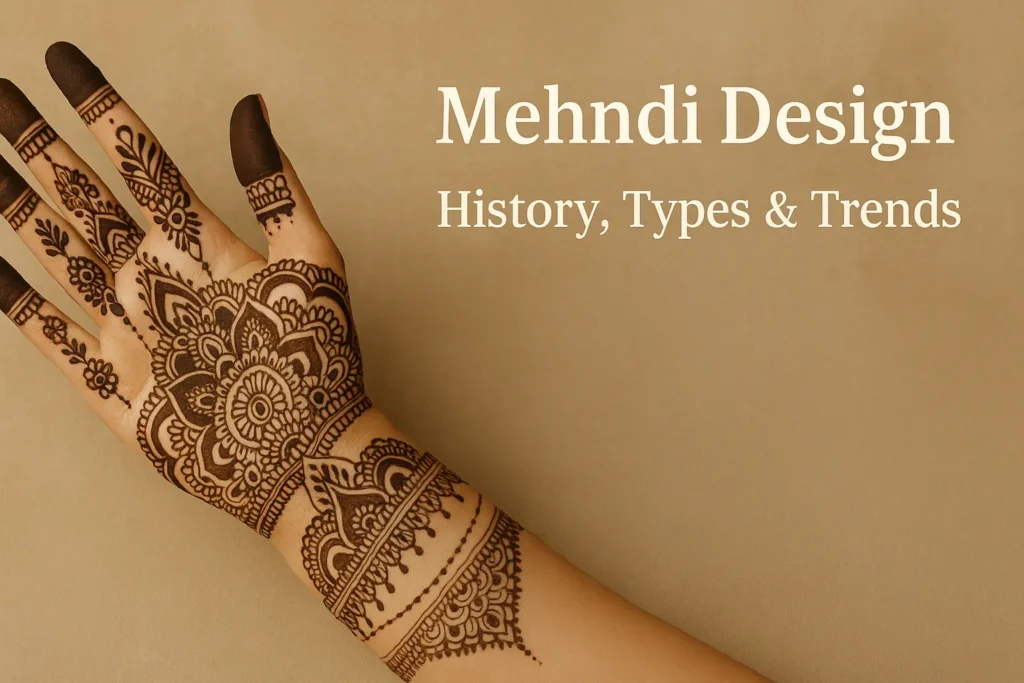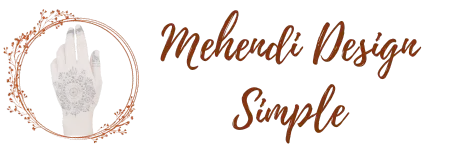Mehndi design, a captivating form of body art, has been adorning hands and feet for centuries. From festive celebrations to weddings, this intricate art form holds cultural significance across continents. But what exactly is Mehndi design? Where did it originate, and how has it evolved into the diverse styles we see today?

Mehndi Design: A Timeless Art of Expression
In this comprehensive guide, we’ll delve into the history, types, and modern trends of Mehndi design, helping you understand its essence and get inspired for your next celebration.
What is Mehndi Design?
Mehndi design refers to the intricate patterns created using a natural paste made from the powdered leaves of the henna plant (Lawsonia inermis). Applied to the skin—most commonly hands and feet—these designs stain the skin in deep red, orange, or brown hues after a few hours.
The word “Mehndi” comes from the Sanskrit word ‘Mendhika’, which means the henna plant. Mehndi is applied not only for aesthetic appeal but also for its cooling and medicinal properties.
Key Characteristics of Mehndi Design:
- Temporary and plant-based
- Symbolic of joy, celebration, and prosperity
- Used in weddings, festivals, and cultural events
- Includes floral, paisley, mandala, geometric, and modern elements
The Origin of Mehndi: A Cultural Legacy
The origin of Mehndi can be traced back over 5,000 years to ancient Egypt, where it was used to adorn mummies and for cooling the body in hot climates. However, its widespread use in India, the Middle East, and North Africa established Mehndi as a symbol of celebration and spirituality.
Historical Highlights:
- Egyptians used henna for mummification and as a beauty enhancer.
- Indian texts and scriptures mention henna being used in weddings and religious rituals.
- Islamic culture adopted Mehndi, incorporating it into Eid, weddings, and Ramadan celebrations.
Mehndi Design History Through the Ages
Ancient Times
Mehndi was initially used for its cooling and therapeutic properties. In dry, hot climates like Rajasthan and Egypt, people applied henna on their palms and soles to reduce body heat.
Medieval Era
With the expansion of trade routes and Islamic influence, Mehndi spread across Persia, Turkey, and the Indian subcontinent. It became a staple in wedding rituals and was considered auspicious for brides.
Colonial and Modern Era
During British colonization, Indian customs including Mehndi gained Western interest. In the 20th and 21st centuries, Mehndi became globalized, making appearances in fashion shows, pop culture, and music videos.
Types of Mehndi Design
There are various types of Mehndi styles, each with its own unique characteristics and cultural significance. Here’s a breakdown of the most popular ones:
1. Indian Mehndi Design
- Highly intricate and detailed
- Features peacocks, paisleys, florals, and mandalas
- Often covers full hands and feet
- Common in weddings and traditional festivals
2. Arabic Mehndi Design
- Less intricate, more bold and flowing
- Uses larger floral patterns and trails
- Leaves more skin exposed
- Quick to apply and gaining popularity for modern events
3. Pakistani Mehndi Design
- A blend of Indian and Arabic styles
- Includes net patterns, domes, and minarets
- Denser application and great for traditional events
4. Moroccan Mehndi Design
- Geometric patterns and tribal symbols
- Inspired by North African heritage
- Usually minimalist, yet symbolic
5. Western or Contemporary Mehndi Design
- Fusion of tattoo-style and boho patterns
- Includes elements like dreamcatchers, mandalas, or zodiac signs
- Popular in music festivals and among celebrities
Symbolism and Cultural Significance
Mehndi designs are not merely ornamental. Each motif has symbolic meaning:
- Peacocks: Beauty and elegance
- Paisleys: Fertility and luck
- Mandala Circles: Spiritual growth and eternity
- Vines and Leaves: Devotion and vitality
- Bride-Groom Figures: Love and marital bliss
In Indian and Pakistani weddings, the darker the Mehndi stain on a bride’s hands, the stronger the love between the couple is believed to be.
Modern Trends in Mehndi Design
As fashion evolves, so does Mehndi design. Here’s what’s trending in 2025:
1. Minimalist Mehndi
- Clean lines and fewer elements
- Popular among millennials and Gen Z
- Suitable for casual or non-traditional events
2. White and Glitter Mehndi
- Colored or glitter-infused pastes
- Used for photoshoots or themed parties
3. Mehndi Tattoos
- Temporary tattoos mimicking traditional henna
- Ideal for those who want the look without the stain
4. Bridal Portrait Mehndi
- Designs featuring bride and groom portraits, wedding motifs, or vows
- Customized and extremely detailed
5. Mix and Match
- Combining traditional and modern motifs
- Personalized names or dates within designs
Tips for Getting the Best Mehndi Stain
To ensure your Mehndi design comes out rich and long-lasting, follow these steps:
- Choose quality mehndi paste – natural, chemical-free henna works best.
- Clean skin before application – avoid oils and lotions.
- Let it dry naturally – no blow-drying or heating.
- Leave it on for 6–8 hours – the longer, the better.
- Seal with lemon-sugar spray – helps darken the stain.
- Avoid water for 24 hours – let the stain oxidize and deepen.
DIY Mehndi: How to Make Mehndi Paste at Home
Ingredients:
- 100g natural henna powder
- 1/2 cup lemon juice
- 2 tablespoons sugar
- 2 tablespoons essential oil (eucalyptus or tea tree)
Steps:
- Sift henna powder to remove lumps.
- Mix in lemon juice gradually to form a smooth paste.
- Add sugar and essential oil.
- Cover with plastic wrap and let it rest for 6-12 hours.
- Fill cones and apply!
Mehndi Design for Occasions
1. Bridal Mehndi
Full-hand and foot designs with symbols of love, couple portraits, and intricate details.
2. Festival Mehndi
Lighter designs for Diwali, Eid, Karva Chauth, and other celebrations.
3. Baby Showers or Godh Bharai
Designs featuring toys, baby motifs, or blooming flowers.
4. Engagement or Sangeet Nights
Trendy patterns with minimal details or highlighted initials.
Common Mistakes to Avoid with Mehndi
- Using black henna (contains harmful chemicals like PPD)
- Washing hands immediately after application
- Skipping skin prep (oils or lotions create barriers)
- Not letting the paste dry properly
- Not wrapping or sealing it when needed for darker stain
FAQs About Mehndi Design
Q1: What is Mehndi Design used for?
A: Mehndi design is traditionally used for weddings, festivals (like Diwali and Eid), and celebrations. It’s also applied for beauty and cultural expression.
Q2: What is the origin of Mehndi?
A: Mehndi originated over 5,000 years ago, likely in ancient Egypt or India, and spread across Asia and the Middle East.
Q3: Are there different types of Mehndi?
A: Yes, the major types include Indian, Arabic, Pakistani, Moroccan, and Western Mehndi styles.
Q4: Is Mehndi safe for all skin types?
A: Natural henna is generally safe, but black henna may contain chemicals like PPD that can cause allergic reactions. Always do a patch test.
Q5: How long does Mehndi last?
A: Mehndi designs typically last 1–2 weeks, depending on skin type, paste quality, and care.
Conclusion: Celebrate With Every Design
Mehndi design is more than just beautiful art—it’s a reflection of culture, celebration, and tradition. Whether you’re a bride preparing for your big day, celebrating Eid, or just expressing your creativity, there’s a Mehndi style for every occasion.
With its rich history and evolving trends, Mehndi continues to bridge generations and cultures. So next time you’re looking to celebrate or mark a special moment, let Mehndi be your canvas.

